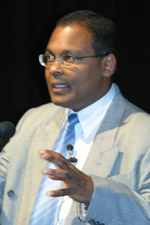|
|
D-r Gunaratna: Core Al Qaeda strength is under 500Rohan Gunaratna is the world’s foremost expert on Islamist
terrorism. The Sri Lankan native has interviewed more than 200 Al Qaeda
members and has written six books on armed conflict. From 2000 to 2001 he
served as principal investigator for the United Nations’ Terrorism Prevention
Branch. He is author of best-seller “Inside Al Qaeda” ( - As I understand Al-Qaeda "classic"
structure and tactics have been destroed after cuptures of Ramzi Binalshibh and
Khalid Sheikh Mohammed. Operative staff in the time of Khalid Sheikh Mohammed
was likely to organize very complex attacks like 9/11 and other, but not now.
After - Very difficult to attack US and - Who is Khalid Sheikh Mohammed successor? - Saif Al Adel - he is in - Can you estimate the Al-Qaeda members number? - Core Al Qaeda strength is under 500. AQ associate membership is several tens of thousands. - In October 2004 French counterintelligence DST published report about Al-Qaeda structure - Ben-Laden, 5 co-founders, shura, 8 committees and some independent terrorist organisations. What do you think about this sheme? Correct. - What do you think how Al-Qaeda was changed principally from 2001 to 2005? - The international terrorism landscape has
changed dramatically during the past three years. First, Al Qaeda has
transformed from a group into a movement; second, the epicentre of international
terrorism has shifted to The most profound of these three developments
is the morphing of Al Qaeda from a group into a movement. With the dispersal of
Al Qaeda from
The initial evidence of this transformation comes by examining the tactics used and the targets selected by the local groups. - Can you give any examples? - For instance, Jemaah Islamiyah, a group
aiming to establish an Islamic state in The full implications of
the transformation of Al Qaeda from a group into a movement has not been
adequately assessed either by the security and intelligence community or the
academic community working on terrorism. While the threat posed by Al Qaeda is
known and manageable, the multiple threats posed by its associated groups has not
been fully studied and assessed. Even within the In the future, Al
Qaeda, the most hunted terrorist group in our history, will pose a lesser
threat compared to its associated groups. Among such groups, Abu Musab Al
Zarkawi's Tawhid Wal Jihad (renamed the Al Qaeda of the Two Rivers), with a
fledgling network in the Middle East and the West, already presents a much
bigger threat to the US, to its Allies and friends. In place of one Al Qaeda,
the core group led by Osama bin Laden, we are now confronted by many Al Qaedas.
Al Qaeda's biggest success has been its ability and willingness to inspire and
instigate a global family of jihad groups. Al Qaeda achieved this singular
success by attacking - You opinion about al Zarkavi and ben Laden relations? - Zarkawi is the new Bin Laden. Zarkawi wanbts
to be what Bin Ladenb was in - Who can be contender of Ben Laden inside organisation? Or it's impossible? - Ayman Al Zawahiri is the successor not contender. - Can you estimate Al-Qaeda role in
modern - Most Active grou in - What do you think about presence of Al-Qaeda
in - Al Qaeda has infiltrated - What about - They are quite significant in - What do you think where is ben Laden now? - I think, Afghanistan-Pakistan border |
|||||||||



